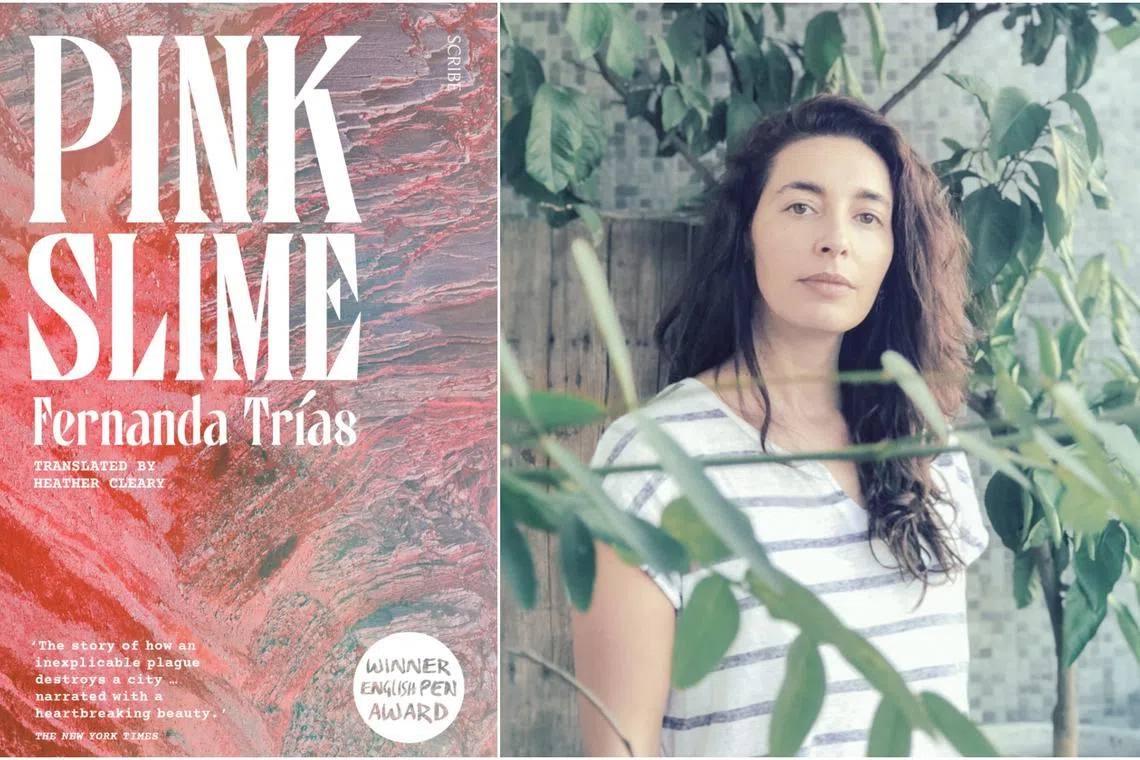Book review: Pink Slime by Fernanda Trias is set in a post-apocalyptic port city of poison
Sign up now: Get ST's newsletters delivered to your inbox

Pink Slime by Uruguayan author Fernanda Trias has been translated from Spanish to English by Heather Cleary.
PHOTOS: SCRIBE
Follow topic:
Pink Slime
By Fernanda Trias, translated by Heather Cleary
Science fiction/Scribe/Paperback/224 pages/$27.21/Amazon ( amzn.to/45fbViB
4 out of 5
In a port city where toxic algae in the water results in a deadly red wind that infects anyone it touches, an unnamed woman waits for an ambiguous end.
Uruguayan author Fernanda Trias’ dystopian novel won a slew of Latin-American literary awards and has now been translated from Spanish into English by Heather Cleary.
It is an unnerving read, pervaded by a creeping dread both environmental and emotional, as the narrator clings to life in a city that is being slowly poisoned.
She quit her copywriting job at a content agency after having churned out one too many filler pieces to distract the public from the ongoing catastrophe.
Now, she works as a caregiver for Mauro, an obese child with an unknown syndrome that afflicts him with insatiable hunger.
His wealthy parents, who have moved inland to escape the red wind, pay the narrator handsomely to look after a son they cannot tolerate. She constantly cycles through a spectrum of emotions towards her difficult charge: exhaustion, disgust and love.
Outside of caregiving, the narrator maps her days through her movements around the city, even as cab rides grow staggeringly expensive and walking risks fatal exposure to the red wind.
She pays visits to her distant, dismissive mother and her former husband Max, who went out into the red wind in a self-destructive moment and is now dying in the clinic.
As the algae creeps closer, food grows scarce and more people flee the city, the narrator conceives of a plan to escape with the money she has saved, yet remains in stasis.
The prose slips often into future tense, as events unfold inexorably upon her. “I cannot stop a future that has already arrived,” she says.
There is much in this novel, first published in 2020, that recalls the early days of the Covid-19 pandemic – the empty city like an “egg carton”, the overflowing hospitals, the swiftly widening gulf between the haves and the have-nots.
Trias, however, is working in the more abiding vein of ecological horror. What befalls her fictional setting is not far removed from real-life toxic cities around the world, where environmental pollution and economic inequality trap many in crises they cannot escape.
Scarcity, hunger and the endless demands of the body haunt the novel as much as the invisible plague. Left unattended, Mauro will devour anything in reach: preserves, trash, even his own flesh.
The red wind causes the skin of those it touches to fall off. A cab driver who has ferried an infected person tells the narrator: “It’s like they’re being… skinned alive.”
The title refers to a processed meat paste that most of the city’s population is forced to subsist on when the food supply chain collapses.
“Pink slime” is a real meat by-product that manufacturers call “lean finely textured beef”, which is centrifuged and treated with ammonium hydroxide.
“That’s what we are when we’re born,” thinks the narrator, “meat paste gasping for air, little balls of pink slime”.
It may be an acquired taste, but in the slurry of dystopian fiction churned out by the publishing industry, Pink Slime certainly stands out.
If you like this, read: Borne by Jeff VanderMeer (Farrar, Straus and Giroux, 2017, $30.70, Amazon, go to amzn.to/45ct8ca
This article contains affiliate links. If you buy through these links, we may earn a small commission.


